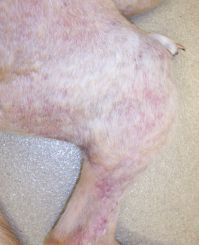Dog Skin Conditions: Superficial Bacterial Folliculitis

Photo courtesy David A. Senter, DVM
Cause: Most commonly, Staphylococcus (“staph”) bacteria, usually secondary to other skin disorders such as allergies, demodicosis (mange), endocrine problems, trauma, foreign bodies, and many others.
Symptoms: Shorthaired dogs often have patchy hair loss, tufts of hair raised above the coat surface and/or reddish or brown “staining” of white hairs. Longhaired dogs may have more subtle symptoms, including scaly skin, dull coat, and excessive shedding. Regardless of coat type, clipping may be necessary to fully reveal the extent of the disorder. The underlying skin lesions include bumps, pimples, crusts, or scales occurring singly, in clusters, or over large areas; reddened circular hairless areas with or without darker pigmentation in the center; scaly or crusty skin may surround the individual lesions in a circular pattern (epidermal collarettes). The degree of itchiness varies from intense to non-existent.
Treatment: Oral antibiotics for three to four weeks or longer, depending on the response; antibacterial shampoos; antibacterial ointments or sprays. Because superficial bacterial folliculitis occurs secondary to other disorders, identification and concurrent treatment of the underlying cause are essential for successful resolution.
Disclaimer: DogChannel.com’s Dog Skin Conditions are intended for educational purposes only. They are not meant to replace the expertise and experience of a professional veterinarian. Do not use the information presented here to make decisions about your dog’s ailment. If you notice changes in your dog’s health or behavior, please take your pet to the nearest veterinarian or an emergency pet clinic as soon as possible.





